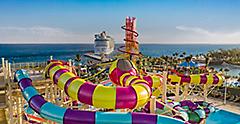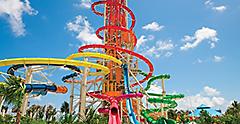Amusement Parks History: From Then To Now
By Chantae Reden | Published on March 22, 2022
Our love of thrills and entertainment is seen in the success of businesses that range from small fairs to ginormous amusement parks. The combination of sugary treats, lively performances and rides that loop and turn results in memories that last a lifetime. But where did our affinity for these attractions come from? Buckle up and keep your arms inside as we dive into the fascinating history of theme parks and how they've changed over the decades.
Fun Through The Centuries
The ancestors of theme parks popped up in Europe just before the Renaissance era, which took place from 1300 to 1600. Themed festivals were typically centered around religious holidays and harvests, and people gathered to enjoy food and admire exotic wares brought from faraway lands. If you wanted to take a ride, you'd sit in a basket and be spun around a pole in what was the first iteration of the modern carousel. Hand-eye coordination was tested through games that included hurling javelins through rings as well as archery and darts. Crowds gathered to watch knights show off their horsemanship through jousting.
In the 18th century, pleasure gardens sprung up in major cities in Europe to entertain the rising middle class. With excess cash to spend and newfound leisure time, citizens were ready to be entertained.
At these pleasure gardens, visitors could stroll among manicured grounds and enjoy live music, acrobats, plays, jesters and firework shows. They became places for people to socialize and play games with others that one might not encounter in everyday life, all while showing off their best clothes. Local architects would reveal their latest creation and artists exhibited their finest works, creating a way for the general public to view art pieces that would once have been kept behind closed doors.
By the mid-1700s, news of the fun of pleasure gardens traveled across the ocean and the concept took hold in America, with pleasure gardens opening in New York City. Rides were added to the mix, including the first carousel on the continent, and a demand for more sophisticated rides grew.

Book Now
The Boom Of Amusement Parks
In the late 1800s, pleasure gardens gave way to entertainment areas that more closely resemble the thrill-seeking theme parks we know and love today. Because the trolley companies paid a flat fee for electricity each month, they needed to entice people to use trolleys outside of peak hours. They built small parks with minor rides, picnic areas and games so people would use the trolleys in the evenings and on the weekends.
One of the most famous amusement areas that sprung up as a result of a well-thought-out rail line was Coney Island. After a long week of work and school, families viewed Coney Island as an affordable way to escape to the seaside during the summer. Rides, games, fortune-tellers and street performances sprang up to delight those who came to visit.

In 1884, the Switchback Gravity Pleasure was invented by LaMarcus A. Thompson, becoming the first roller coaster in the United States. The roller coaster had a maximum speed of a little under six miles per hour and topped out at 50 feet high, but at the time, the ride was thrilling, especially for those who had never experienced anything like it.
The roller coaster inspired entrepreneurs to build multiple parks on Coney Island, which is still famous for its rides and games today. Coney Island became a hub for amusement park rides — innovative roller coasters were often invented and built elsewhere, then sent to Coney Island. People would gather their friends and family on the weekend, ride in from the outer suburbs on the subway and snack on a hot dog in between rides.

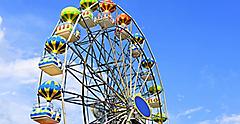
Meanwhile, an eclectic showman with a penchant for water stunts named Paul Boyton made a reputation for himself after completing a series of water challenges and performing in P.T. Barnum's circus. After settling down in Chicago, Boyton established the country's first permanent amusement park, called Paul Boyton's Water Chutes, in 1894. The success of the park inspired him to open a second amusement park on Coney Island.
The amusement park industry boomed throughout the early 1900s. By 1920, there were hundreds of parks across the country. The rise in industrialization and more efficient transportation allowed workers to work for less time, giving them more time to escape into worlds of fun and fantasy. Ride engineers raced to build roller coasters and the competition among the engineers was fierce. Advertisements full of superlatives like "tallest," "fastest" and "longest" attempted to lure people to each park's grounds.
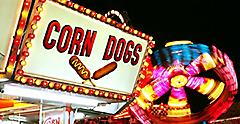
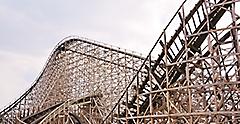
Prepare For An Abrupt Stop
The Great Depression caused an economic downturn in the global economy, leading to the closure of hundreds of theme parks worldwide. World War II followed in 1939, which meant time and resources needed to be spent on wartime efforts rather than building the next best ride. Though some people visited theme parks as a respite from the harsh reality of everyday life, the industry struggled to attain the same success it had experienced during the previous decades.
Theme Parks Take Center Stage
The baby boom began in 1944 and the rise of kid-friendly theme parks followed. Until the 1950s, amusement parks had targeted families of all ages with few that catered solely to young children, but then Arthur Fritz started a chain of parks for budding boomers called "Kiddieland" and many other copycat parks followed.
In the mid-1950s, Disneyland emerged as the nation's first large park centered around a specific theme. Theme park developers struck gold when they centered their parks around themes like the Wild West and dinosaurs and introduced more rides that made guests wonder if the corn dog they had eaten just moments before was going to reappear.
Though waterslides had been around for decades, the country's favorite summertime pastimes — amusement parks and going for a dip in the pool — combined at theme parks in the 1980s. When "Baywatch" debuted in 1989, flashes of bright red swimwear accented the parks as visitors copied the lifeguards' signature red bathing suits.


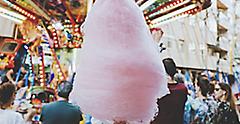
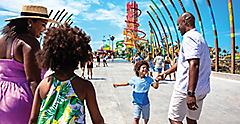
The Amazing Amusement Parks of Today
Amusement parks have pushed the boundaries of what's possible in entertainment. At Perfect Day at CocoCay, travelers exploring the seas on a cruise can have a day of seaside relaxation and nonstop thrills at a private island in the Bahamas. Reach new heights when you zoom down the tallest waterslide in the Caribbean before going for a ride on Up, Up and Away, a helium balloon ride taking you to the highest vantage point on the island as you tower above the Thrill Waterpark for unforgetable views. When it's time to relax, the beach is there for those looking to lounge in the cool sand and take a dip in the aquamarine sea.
Theme parks still offer a retreat from everyday life and allow us to live in a world of fantasy. Where else can we feel the excitement that builds in our stomachs as our roller coaster car crawls to the top of its first peak, metal gears clanking underneath? These parks allow us to leave our worries behind and let us imagine what it feels like to fly and to travel at the speed of light. Amusement parks are places where the only thing to do is spend time having fun.





